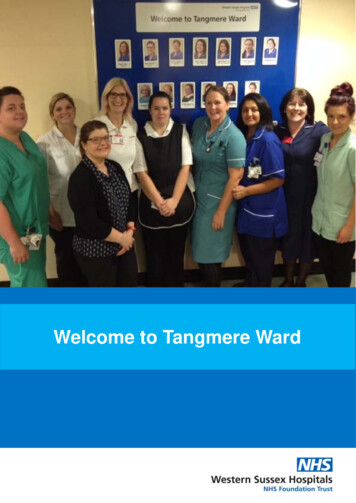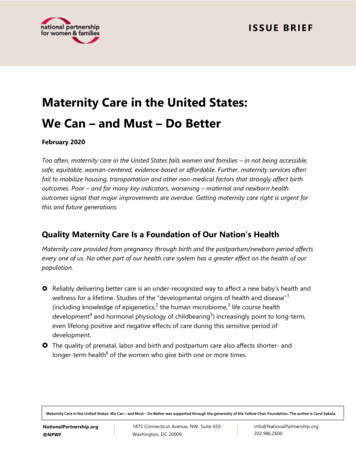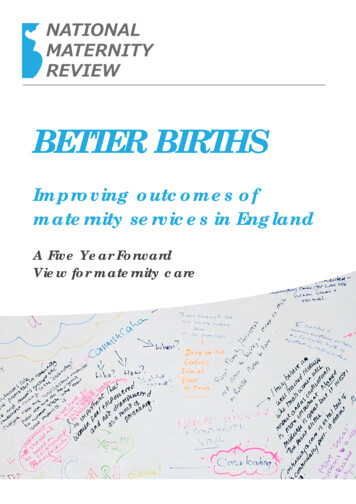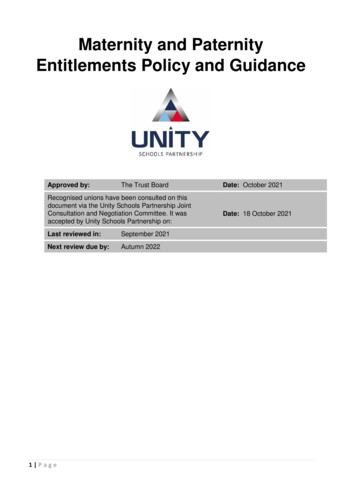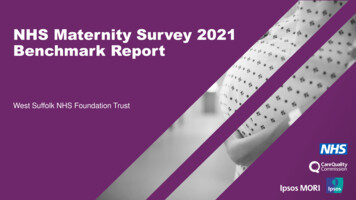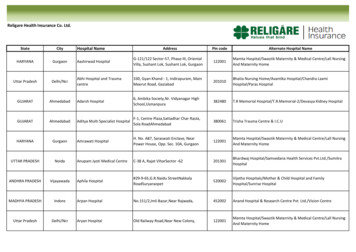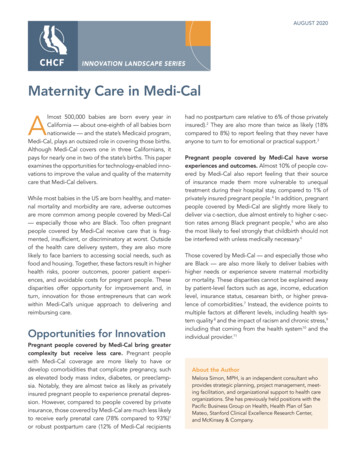
Transcription
AUGUST 2020INNOVATION LANDSCAPE SERIESMaternity Care in Medi-CalAlmost 500,000 babies are born every year inCalifornia — about one-eighth of all babies bornnationwide — and the state’s Medicaid program,Medi-Cal, plays an outsized role in covering those births.Although Medi-Cal covers one in three Californians, itpays for nearly one in two of the state’s births. This paperexamines the opportunities for technology-enabled innovations to improve the value and quality of the maternitycare that Medi-Cal delivers.While most babies in the US are born healthy, and maternal mortality and morbidity are rare, adverse outcomesare more common among people covered by Medi-Cal— especially those who are Black. Too often pregnantpeople covered by Medi-Cal receive care that is fragmented, insufficient, or discriminatory at worst. Outsideof the health care delivery system, they are also morelikely to face barriers to accessing social needs, such asfood and housing. Together, these factors result in higherhealth risks, poorer outcomes, poorer patient experiences, and avoidable costs for pregnant people. Thesedisparities offer opportunity for improvement and, inturn, innovation for those entrepreneurs that can workwithin Medi-Cal’s unique approach to delivering andreimbursing care.Opportunities for InnovationPregnant people covered by Medi-Cal bring greatercomplexity but receive less care. Pregnant peoplewith Medi-Cal coverage are more likely to have ordevelop comorbidities that complicate pregnancy, suchas elevated body mass index, diabetes, or preeclampsia. Notably, they are almost twice as likely as privatelyinsured pregnant people to experience prenatal depression. However, compared to people covered by privateinsurance, those covered by Medi-Cal are much less likelyto receive early prenatal care (78% compared to 93%)1or robust postpartum care (12% of Medi-Cal recipientshad no postpartum care relative to 6% of those privatelyinsured).2 They are also more than twice as likely (18%compared to 8%) to report feeling that they never haveanyone to turn to for emotional or practical support.3Pregnant people covered by Medi-Cal have worseexperiences and outcomes. Almost 10% of people covered by Medi-Cal also report feeling that their sourceof insurance made them more vulnerable to unequaltreatment during their hospital stay, compared to 1% ofprivately insured pregnant people.4 In addition, pregnantpeople covered by Medi-Cal are slightly more likely todeliver via c-section, due almost entirely to higher c-section rates among Black pregnant people,5 who are alsothe most likely to feel strongly that childbirth should notbe interfered with unless medically necessary.6Those covered by Medi-Cal — and especially those whoare Black — are also more likely to deliver babies withhigher needs or experience severe maternal morbidityor mortality. These disparities cannot be explained awayby patient-level factors such as age, income, educationlevel, insurance status, cesarean birth, or higher prevalence of comorbidities.7 Instead, the evidence points tomultiple factors at different levels, including health system quality 8 and the impact of racism and chronic stress,9including that coming from the health system10 and theindividual provider.11About the AuthorMelora Simon, MPH, is an independent consultant whoprovides strategic planning, project management, meeting facilitation, and organizational support to health careorganizations. She has previously held positions with thePacific Business Group on Health, Health Plan of SanMateo, Stanford Clinical Excellence Research Center,and McKinsey & Company.
INNOVATION IN ACTIONThese brief profiles focus on technology and workforce innovations piloted recently in Medi-Cal. While these examples are notexclusively mediated by managed care plans, it is important to note that many of them are, and that pregnant people covered byMedi-Cal fee-for-service are less likely to have access to these innovations.Navigating Pregnant People to Better OutcomesIn 2017, patient engagement and navigation companyDocent Health partnered with Dignity Health, a healthcare delivery system now part of CommonSpirit Health, toprovide extra support to pregnant people, with the goal ofavoiding poor maternal outcomes.Innovation. Following an interaction with the health system, Docent Health connects members with lay “docents”or navigators that help triage members’ needs and connect them with appropriate services and information.Scope. Over the course of the pilot, which started in 2017and is now being rolled out across the CommonSpirit system, more than 20,000 pregnant people and their familiesacross three unique markets and all payer types used Docent’s services. Two-thirds of participants actively engagedwith Docent’s offerings, most often to find relevant resources, prepare for their inpatient experience, or to follow upafter returning home with key questions or concerns.Impact. Patients with Medi-Cal coverage engaged byDocent had a statistically significant lower average lengthof stay and NICU days, and had higher rates of full-termdeliveries and healthy birthweight infants, relative toMedi-Cal patients not engaged by Docent. CommonSpiritreported that Docent “provided additional touches withpatients efficiently while optimizing tasks that were previously assigned to care teams.”Lessons learned. The accessibility of Docent’s navigatorscreated a new pathway for patients to have issues addressed and escalated as appropriate. Digital communication methods, like texting, proved critical for engagingmembers. One challenge was evaluating the impact of Docent on measures related to patient satisfaction and returnon investment. Impact related to clinical outcomes andworkflow were easier to discern. Even though Docent wasa new tech-enabled service, CommonSpirit staff reportedthat it reduced the workload of frontline team membersrather than adding to it. Overall, the pilot affirmed for theCommonSpirit team that a robust supporting platform is avital piece of any effort to close disparities related to socialrisk factors.California Health Care FoundationEngaging Members in EducationalMaternity ContentIn 2018, Wildflower, a maternity-focused digital healthcompany, partnered with two Medi-Cal plans, Blue ShieldPromise and Inland Empire Health Plan (IEHP), to fill aneed for accessible, evidence-based educational information for pregnant members.Innovation. Wildflower offered both plans a patient-facingeducational app available in English and Spanish. IEHPchose to offer members a more tailored version, whichcustomized the information displayed based on the member’s population-specific risk factors and locally availableresources.Scope. Blue Shield Promise offered the app to members inSan Diego County, while IEHP offered the app to all pregnant members in Riverside and San Bernardino Counties.Over the course of a formal pilot, 47 Blue Shield members used the app, representing about 1% of births at theparticipating clinics. IEHP continues to offer the app, andit has been downloaded by 1,864 members to date, representing just under 10% of births in the same time period.Impact. Across both plans, Wildflower found that lessthan one-third of those who downloaded the app did soin their first trimester. For IEHP, 95% used the English version (though Spanish was also available) and two-thirds ofmembers completed a risk factor survey, which enabledthe plan to offer care management and/or behavioralhealth resources. Using a case-control study, IEHP foundthat members who used the app had an increased likelihood of completing a postpartum visit within eight weeksof birth, but were no more likely to promptly connect toprenatal care.Lessons learned. Relatively low uptake in both situationsreaffirmed the importance of dedicating resources topromoting any new tool available for members and thechallenges of plans as an engagement partner, as theyoften do not know about a pregnancy until the second trimester. As a result, clinic partners, especially FQHCs, werecritical to outreach — as was the use of digital communication methods, such as texting. One notable challenge wasfinding a balance between wanting to frequently updatethe app’s content and needing to have content approvedby plans and regulators. Opportunities for future improvement identified including engaging members earlier intheir pregnancies and more closely linking the app’s content to clinical care.www.chcf.org2
Structure of Maternity Carein Medi-Cal Relatively low priority for plans. Delivery is ahigh-cost service, with median spending of about 7,000 per live birth, compared to about 2,100 inaverage annual spending per year per beneficiary forchildren and 4,700 for childless adults. However, itis significantly lower than the 19,600 average annualspending per year per beneficiary for people withdisabilities. An estimate using median spending perlive birth and the number of live births covered byMedi-Cal suggests that pregnant people make up1.4% of Medi-Cal enrollees and account for 1.8%of spending. In other words, although Medi-Cal is avery important player in maternity care in California,maternity care is a relatively small piece of all thatMedi-Cal covers. Fragmented risk. All Medi-Cal managed care plansare partially insulated from the risk of costly birthsrequiring the neonatal intensive care unit (NICU),and some have almost no risk. In 37 of California’s58 counties, Medi-Cal carves out the most intensivenewborn care from managed care plans and covers it under the FFS system through the CaliforniaChildren’s Services (CCS) program.12 As of July 2019,incentives are more aligned in the other 21 counties,where the Whole Child Model integrates coordination and financing for all required newborn care andthe care of children with special health care needs.13However, even in these counties, plans receive anenhanced capitation rate for children enrolled inthe CCS program. As a result of the payment policies — which were designed to improve access andcoordination for this population — plans are notincentivized to invest in the prenatal care and wraparound services critical to prevent the kinds of poorneonatal outcomes that require NICU care.The structures and policies that determine where maternity care happens and what providers get paid for it driveaccess and outcomes. Understanding how those policiesdiffer within the Medi-Cal system is the key to identifyingand operationalizing successful innovations.PaymentWhen it comes to maternity care, Medi-Cal’s approach topaying providers differs from other payers in key ways: The 40/60 split. Despite Medi-Cal largely shiftingtoward managed care overall, 40% of births paid forby Medi-Cal are still covered by the fee-for-service(FFS) system. The rest are covered by managedcare. The majority of FFS births are to two groupsof people that become newly eligible for Medi-Calon the basis of their pregnancy: those unable toverify satisfactory immigration status and those withincomes 139% to 213% above the federal povertyline. These 40% of pregnant people covered by theFFS system do not benefit from the access, coordination, innovation, and quality-improvement activitiestypical of Medi-Cal managed care plans.Lower reimbursement. For nearly all maternity careservices, Medi-Cal reimbursement rates are significantly lower than commercial reimbursement rates.In Sacramento, for example, commercial rates can be4 times as high for hospitals, and 10 times as high foranesthesiologists, when compared to Medi-Cal FFSrates. According to leaders interviewed for this paper,managed care plans often pay more than Medi-CalFFS but still significantly less than commercial plans.These reimbursement disparities also exist in othertypes of care such as oncology and orthopedics, butmaternity providers see a much larger portion ofMedi-Cal patients than do providers in most otherspecialties.Maternity Care in Medi-Calwww.chcf.org3
ProvisionOther differences in maternity care covered by MediCal have to do with the people and places that deliverthis care. Appendix B details the different professionsinvolved in maternity care and their reimbursement byMedi-Cal. Importance differences here include: Lack of continuity across the perinatal episode.For privately insured patients, the same clinician(or at least a clinician from the same medical group),typically provides prenatal and postpartum care andis the birth attendant. This is less likely to be true forpregnant people covered by Medi-Cal. Only half ofthose who received prenatal care from a FederallyQualified Health Center (FQHC) or Look-Alike14 hadan FQHC provider as their birth attendant.15 ManyFQHC providers do not serve as birth attendants dueto the unique financing of FQHCs,16 resulting in alack of continuity of care at a particularly vulnerabletime. Instead, deliveries are typically handled by anon-call physician, contracted by the hospital, andoften unknown to the pregnant person. Indeed, anational survey reported that 25% of Black and 23%of Latinx pregnant people had never met their birthattendant.17Smaller role for midwives despite greater demand.Midwives attended just 6.8% of Medi-Cal births compared to 16% of privately insured births in Californiain 2018.18 However, three times more people withMedi-Cal coverage want a midwife than actuallyuse them.19Small role for freestanding birth centers despiteevidence of effectiveness. More than 99% of allbirths, including Medi-Cal births, currently take placein hospitals, and hospitalization for pregnancy andchildbirth is the number one reason for hospitalization in California.20 Use of freestanding birth centersis a covered benefit and has been shown to have apositive impact on birth outcomes among peoplecovered by Medicaid.21 However, less than 4 in 1,000Medi-Cal births currently take place outside the hospital22 despite 100 in every 1,000 pregnant peoplewith Medi-Cal coverage saying they would like togive birth in a freestanding birth center.23California Health Care Foundation Greater role for allied health professionals. Healtheducation, nutritional support, and psychosocialservices are covered benefits in Medi-Cal through aunique program called the Comprehensive PerinatalServices Program (CPSP).24 These services, which areintegrated into prenatal and postpartum care, canbe delivered by licensed staff or by lay communityhealth workers, and in multiple settings, includingindividually or in groups, and in the home. In addition, doulas25 are slightly more likely to supportpregnant people covered by Medi-Cal than thosewith commercial insurance, in spite of the fact thatlabor support provided by doulas is not a coveredbenefit.26 This may be because some safety-net hospitals offer free hospital-based doula services.Implications for InnovatorsMore than 7 of 10 of California’s pregnant people arepeople of color. That number rises to more than 8 in10 for those covered by Medi-Cal. Improving the outcomes and experiences of California’s pregnant peoplerequires providing care that is culturally and linguisticallyconcordant, that integrates medical and psychosocialneeds, and that addresses potential sources of bias anddiscrimination within the health care system. Innovatorsalone cannot solve all these problems, but they do havethe power to help address them.Plans have limited business incentives to reduce thetotal cost of care, but are eager to improve performance on measures of timely prenatal and postpartumcare, including mental health. Though Medi-Cal paysfor many births, maternity spending is not significantrelative to spending on other conditions. In addition, thecarve-out of most NICU costs from Medicaid managedcare plans means that much of the potential cost savings from investment in upstream interventions will notbe recouped by the plans. When plans do realize savings, the heavy weighting given to historical costs in thestate’s rate-setting process27 can result in lower futurerates, which discourages investments that reduce costssignificantly.28 As a result, the business case for partnering with health plans to improve outcomes and reducecostly preterm births is not as strong in Medi-Cal as inother markets. Plans are, however, motivated to improvewww.chcf.org4
quality (i.e., HEDIS) scores around timely prenatal andpostpartum care.29 They also articulated, in interviews forthis paper, an interest in improving access and coordination for maternal mental health.INNOVATION TO WATCHImproving Outcomes Through CommunityBased DoulasNot all innovation is through technology. In the lastfew years, several Medi-Cal plans, including Anthem,HealthNet, and IEHP, and a few counties and citiesin California, have partnered with community-baseddoulas, running pilots that pay for doula services forpregnant members to reduce maternal morbidity andmaternal and infant mortality. Many of these pilotshave focused on Black pregnant people as disparitiesin outcomes are most pronounced for this population.These pilots are too recent to show results, but important lessons have been learned about the need, whenlaunching these programs, for strong partnership withand leadership by the community the pilots are aimingto serve. While doula care is not a technology innovation, it meets an important need expressed by patientsthat is associated with improved outcomes. In addition,there are opportunities for technology to expand thereach of doulas.Hospitals seek to reduce overall length of stay forMedi-Cal-covered pregnancies, but have limited business incentives to reduce NICU use in particular. Givenlow rates of reimbursement under Medi-Cal, hospitalsgenerally lose money on Medi-Cal patients, and pregnant people are no exception. As a result, hospitals areseeking solutions that reduce length of stay, ED visits,and readmissions for pregnant people with Medi-Calcoverage. In addition, California hospitals are also underpressure from purchasers and the press30 to reducelow-risk c-section rates, even though in some cases, ac-section may be more profitable than a vaginal birthfor the institution. In contrast, they have limited business interest in reducing NICU admissions because NICUstays receive enhanced Medi-Cal reimbursement and arehighly profitable for hospitals.The quality and financial incentives of FQHCs arebased on the volume of encounters. As a result, theyseek solutions that encourage robust engagement withprenatal and postpartum care and that count toward theirper-visit rate. Many enroll in CPSP, tapping into incremental reimbursement for wraparound psychosocial,educational, and nutritional services. For the most part,FQHCs reported that they are seeking tech-enabledsoftware platforms, rather than service solutions, as theyprefer to hire their own staff. In interviews for this paper,FQHCs articulated pain points around specialty access,care coordination for patients with complex needs, andre-engagement in postpartum care after delivery.Maternity Care in Medi-CalSolutions LandscapeAcross our stakeholder interviews and market research,four categories of companies rose to the surface as beingmost common and most capable of having an impacton maternity care outcomes for people covered byMedi-Cal. See Figure 1 for examples of companies inthese categories:ABehavioral health. Improving access to in-personor virtual behavioral health services tailored to theunique needs of new and expecting parentsAInpatient birth. Supporting providers in improvingthe quality and/or efficiency of the birth episodeAOutpatient care coordination. Addressing fragmentation across the perinatal episode through acombination of education, screening, servicesand/or referrals Parent education and engagement. Deliveringbasic information about prenatal care and birthdirectly to consumerswww.chcf.org5
Among those categories, outpatient care coordination stood out as having the most potential to addressthe unique challenges plaguing maternity care withinMedi-Cal — especially fragmentation. As a result, Table 1dives deeper into companies with both outpatientsolutions and demonstrated experience working inMedi-Cal (see page 7). Appendix A follows with an additional list of maternity care start-ups working across allfour categories that are led by founders identifying aswomen and/or people of color.Figure 1. Maternity Care Company Landscape*OUTPATIENT CARE COORDINATION AND SERVICESINPATIENT BIRTHSOFTWARE AND SERVICESPARENT EDUCATIONAND ENGAGEMENTBEHAVIORAL HEALTH*This landscape is not exhaustive and it is not an endorsement of the companies included in it.California Health Care Foundationwww.chcf.org6
Table 1. Outpatient Care Companies with Medicaid ExperienceSERVICES OFFEREDBabyScriptsDocent HealthMahmeeMaven ClinicOvia HealthWildflower HealthTARGET CUSTOMERS /EXAMPLE CLIENTS IN CALIFORNIA SAFETY NETApp and platform for clinic staff aimingto reduce need for in-person care;remote monitoring solutions for higher-riskpregnancies, including round-the-clocknurse triage lineIntegrated delivery systems, FQHCsServices of lay docents on a tech platformto support patient experience, connection,and triage needsHealth systemsTelehealth and care management platformfor allied health professionalsAllied health professionals, delivery systemsPatient-facing app and network of telehealthproviders to augment in-person careEmployers / health plansPatient-facing engagement app plus nursehealth coachesEmployers / health plansPatient-facing engagement app with robust,evidence-based content and ability to tailorHealth plans, employers, delivery systemsMaternity Care in Medi-CalBorrego HealthCommonSpirit, Sutter HealthCHLA/AltaMed, L.A. Dept. of HealthNo current safety-net clients in CaliforniaNo current safety-net clients in CaliforniaBlue Shield Promise, CommonSpirit, IEHPLANGUAGESEnglish andSpanishStaffing andscripting alignedwith local needsEnglish andSpanishEnglish andSpanishEnglish andSpanishEnglish andSpanishwww.chcf.org7
Appendix A. Companies to Watch — Solutions with Founders Identifying as Women and/or People of ColorThe chart below identifies companies at all stages surfaced through our research and scanning that have foundersidentifying as women and/or people of color. It is not exhaustive, nor an endorsement. These companies are includedbecause the CHCF Health Innovation Fund is committed to using its platforms to help draw attention and mobilize solutions to the disparities that exist in the entrepreneurial sector as a whole, and in the health tech space in particular, asrelatively few ventures are led by women or people of color.IN THEIR OWN WORDS: WEBSITE DESCRIPTIONFOUNDER(S)BabyLiveAdviceA virtual care team to support you from pregnancy to parenthood.Sigi MarmorsteinCulture CareA telemedicine start-up for Black women. Connecting women to physicians,culturally and digitally.Monique SmithMahmee is a HIPAA-secure care management platform that makes it easy forpayers, providers, and patients to coordinate comprehensive prenatal andpostpartum health care from anywhere.Melissa HannaMaven ClinicOn-demand access to virtual care and services built specifically for you —all in one app.Katherine RyderMomswellMomsWell supports the clinical decision-making providers need to identify,educate and support patients with maternal mental health complications,like postpartum depression.Maureen FuraMotherboard Birth[M]otherboard is where education meets collaboration and informeddecisionmaking. Our interactive software helps you create your personalized“[M]otherboard” (aka visual “birth plan”).Amy HadererOula HealthWe’re a multidisciplinary team of obstetricians, midwives, and doulas poweredby technology to deliver exceptional care that extends from our clinics intoyour home.Elaine PurcellOvia HealthOvia Health’s comprehensive maternity and family benefits solution istransforming the way women and families are supported throughout theparenthood journey.Gina NebesarQuilted HealthQuilted Health is better maternity care: evidence-based, community centered,and designed for you.Christine HenningsgaardRadical HealthRadical Health uses indigenous restorative circle practice to create space fora new kind of dialogue between clinicians / health care providers, researchers,service providers, and community members.Ivelyse AndinoSoSheSoShe is the only birth class and customizable birth plan that is app-based,evidence-based, and expert-approved.Shannon FieldWildflower HealthWildflower is reinventing how women connect to care by integrating our personalized digital solution with the provider, the payer, and best-in-class partners.Leah SparksWolomiWolomi is the only digital community that offers support to women of color toimprove maternal health outcomes.Layo GeorgeMahmeeCalifornia Health Care FoundationJoy CooperLinda HannaMelissa GuevaraAdrianne Nickersonwww.chcf.org8
Appendix B. Maternity Workforce — Professions and Reimbursement by Medi-CalEDUCATION REQUIREDDIRECT MEDI-CALBILLINGSupport ProvidersDoulaProvide physical, emotional, and informational labor support to mother before,during, and after birth.No special requirements;certification availableNoLactation Consultant/CounselorCertificationNoLabor and Delivery NurseRegistered nurse providing direct patient care in obstetrics and labor, and/ordelivery and reproductive care.Associate’s, bachelor’s, ormaster’s degree in nursingNo, paid byhospitalsMidwifeCertified Nurse-Midwife (CNM), Licensed or Certified Professional Midwife (LM)CNM: Master’s degree innursingProvide midwifery care, including perinatal, well-woman, and newborn care.May attend births in or outside of hospitals. CNMs require physician supervision.LM: Accredited midwiferyprogram certificateYes, but physiciansupervision timeis not reimbursedPhysicianM.D. or D.O. plus residencyYesClinical PsychologistDiagnose and treat a range of mental health disorders, and provide psychotherapy.Ph.D. or Psy.D. in psychologyYesPsychiatristProvide psychiatric care to adults using medications and/or psychotherapy.M.D. or D.O. plus residencyYesTherapistMaster’s degreeYesInternational Board Certified Lactation Consultant, Certified Lactation CounselorProvide education and counseling to support breastfeeding.Medical ProvidersObstetrician/Gynecologist, Family Physician, OB/GYN HospitalistProvide medical and surgical care to women, including providing pregnancy care.OB Hospitalist specializes in inpatient care, including obstetric emergencies.Behavioral Health ProvidersLicensed Marriage Family Therapist, Professional Clinical Counselor,Clinical Social WorkerProvide counseling or therapy services to groups or individuals to addresswellness, personal growth, and pathology.Notes: This list is based on CHCF correspondence with 2020 Mom, Maternal Mental Health NOW, and Emily C. Dossett, M.D. (Keck School of Medicine, LAC USC),June 2016. It captures only the most common maternal mental health providers.Sources: Medical Board of California; California Board of Registered Nurses; DONA International; International Board of Lactation Consultant Examiners; TheAcademy of Lactation Policy and Practice.Maternity Care in Medi-Calwww.chcf.org9
About the FoundationThe California Health Care Foundation is dedicated toadvancing meaningful, measurable improvements in theway the health care delivery system provides care to thepeople of California, particularly those with low incomesand those whose needs are not well served by the statusquo. We work to ensure that people have access to thecare they need, when they need it, at a price they canafford.CHCF informs policymakers and industry leaders, investsin ideas and innovations, and connects with changemakers to create a more responsive, patient-centered healthcare system.For more information, visit www.chcf.org.Endnotes1. Natality public-use data 2016–2018 (expanded), CDC WONDERDatabase, September 2019.2. Carol Sakala et al., Listening to Mothers in California: APopulation-Based Survey of Women’s Childbearing Experiences,National Partnership for Women & Families, September 2018.3. Sakala et al., Listening to Mothers.4. Sakala et al., Listening to Mothers.5. Natality public-use data 2016–2018 (expanded), CDC WONDERDatabase, September 2019.6. Sakala et al., Listening to Mothers.7. Elizabeth A. Howell, “Reducing Disparities in Severe MaternalMorbidity and Mortality,” Clinical Obstetrics and Gynecology 61,no. 2 (June 2018): 387–99, doi:10.1097/GRF.0000000000000349.8. Elizabeth A. Howell et al., “Black-White Differences in SevereMaternal Morbidity and Site of Care,” American Journal ofObstetrics and Gynecology 214, no. 1 (Jan. 1, 2016): p122.e1–7,doi:10.1016/j.ajog.2015.08.019.9. Stephanie A. Leonard et al., “Racial and Ethnic Disparities inSevere Maternal Morbidity Prevalence and Trends,” Annalsof Epidemiology 33 (May 2019): 30–36, doi:10.1016/j.annepidem.2019.02.007.10. Rachel R. Hardeman, Eduardo M. Medina, and Katy B.Kozhimannil, “Structural Racism and Supporting Black Lives — theRole of Health Professionals,” New England Journal of Medicine375 (Dec. 1, 2016): 2113–15, doi:10.1056/NEJMp1609535.11. Brian D. Smedley, Adrienne Y. Stith, and Alan R. Nelson,eds., Unequal Treatment: Confronting Racial and EthnicDisparities in Health Care, National Academies Press (US), 2003,doi:10.17226/12875.About the Innovation Landscape SeriesAs part of its efforts to help promising products andservices succeed and scale in California’s safety net,the CHCF Health Innovation Fund conducts high-levellandscape analyses of issue areas especially ripe fortech-enabled innovation. The Fund publicizes thefindings of these landscape analyses to inform otherfunders and customers seeking scalable solutions tochallenges in the safety net.Readers should note that these reports are not intended to be exhaustive, nor are they endorsements of thecompanies included in them. Finally, because solutionslandscapes can evolve quickly, these reports may notfully reflect the current market.12. Califor
insurance, those covered by Medi-Cal are much less likely to receive early prenatal care (78% compared to 93%)1 or robust postpartum care (12% of Medi-Cal recipients had no postpartum care relative to 6% of those privately insured).2 They are also more than twice as likely (18% compared to 8%) to report feeling that they never have

